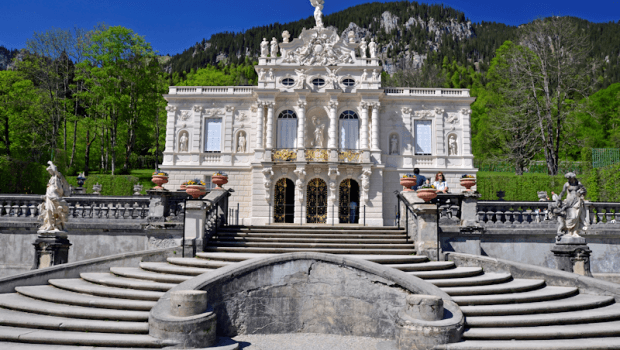
The Royal Villa or the Palace of Linderhof (German: Schloss Linderhof) is situated in the South western Bavarian region of Germany. It is located near to the Ettal Abbey and is known to be the smallest among the three palaces which were built by King Ludwig II of Bavaria. It is also the only palace which could be completed within his lifetime. Linderhof Palace was also regarded by Ludwig II as his favorite and he stayed here the most often.
Linderhof Palace not only resembles the artistic sprit of King Ludwig II but also the furor of the 19th century at large. Much of the designs carried influences from the French architectural styles and Germanic large palaces. You can witness the many Rococo motifs representing the age of Louis XV of France behind the Baroque façade of the palace. Ludwig II is credited to have supported the neo-Rococo styles.
Today you can visit the palace along with its beautiful gardens. The Palace receives a massive amount of footfall each year. Nearly half a million tourists come to visit the favorite palace of the fairy tale king. They come to witness the rich ornamentation designed out of the many sculptural elements and the sumptuousness that surpasses nearly everything. There is the intricate workmanship and the achievements of artistic unity.
About the building
Ludwig II had idolized the Sun-King Louis XIV of France and being inspired from his Palace of Versailles, Ludwig II created many of his palaces. Linderhof Palace was specifically designed to be much smaller than the Palace of Versailles because Ludwig II wanted a certain kind of personal element embedded within the whole design.
The origin of Linderhof
The year was 1864 when Ludwig II became the king and thus began his building construction endeavors. He spent the latter half of the 1860s in redesigning his rooms in the Munich Residenz and also laid the foundation stone for the Neuschwanstein Castle in the same period.
By the time it was 1868 he had commenced his work on the first plans of the Linderhof. But due to the prevailing circumstances his modellings on the Palace of Versailles that was to be constructed on the valley floor and the palace designed on the Byzantine formula – none of them saw the light of the day. What had on the other hand happened was that new buildings sprouted near to the forester’s house which belonged to his father, Maximillian II. They were constructed right in front of the current palace in the open spaces present there. They were used while the King was on his hunting expeditions along with his father. Linderhof Palace was the only palace which Ludwig II saw being completed during his lifetime.
Under the first phase of the construction processes, in 1869 the forester’s house was redesigned and built again and then named as the Royal Lodge. During the next year, directed by George Dollmann a court building came about and a wing with a single axis was also added in the meantime to the building. Also, the original plans of the buildings were redone.
From the spring of 1871 onwards additions were made to the building in the form of a second wing and connecting bedrooms in-between the two wings. A wooden staircase was also added which was located on the western side of the building along with the intricate u-shaped complex around the open courtyard. The Royal Lodge thus became superfluous from which in-fact originated the core of the palace. The upper post carried a wooden post and the lower floor was essentially plastered. Interestingly the wooden structures were known as the Alpine Hut Building.
The building then carried a rather simple exterior and it could have in no manner given hints of the exquisite and splendor which lay inside.
It was also realized that a form of architectural unity will be required when one goes to constructing any building. For this purpose the final places which were approved by Ludwig II in 1873 demanded the wooden constructions to be clad with solid stones and then they were going to be covered using the cross-shaped complex of new roofs. This construction would then go on forming the core of the new palace. A fallacy was also found there – that there were no interior staircases.
The exterior of the palace started taking shape during the first month of 1874 when the Royal Lodge was moved 200 meters away from its then present location. It was then that the vestibules and the staircases were incorporated in the interior sections. The construction process gained pace and by 1876 the southern tracts particular were completed.
Any palatial building also required a landscape park which complements and completes the whole design. In 1874 the final plans of the park were submitted under the guidance of the court garden director Carl Joseph von Effner.
The final building process came about in 1885 and 1886 when the bedrooms and the central room in the complex began to be enlarged. Now, because of this move the entire design of the building was also affected and required substantial amount of redesigning. The completed palace measured 30 c 27 meters. However King Ludwig II died in 1886 while the bedrooms were being enlarged and thus could not see that being done.
The building has many rooms but most of them did not really have any function. Following is a list of the rooms and other buildings:
- Hall of Mirrors
This was designed to be the living room of the king and it is here that he would spend much of his time sitting in the niche and reading, at time the whole night. Ludwig II was known to have been sleeping during the day time and staying awake during night time. Thus mirrors were created so that they would reflect the moonlight and other sources, and illuminate the room. Moreover, the placement of the mirrors in a parallel form also provided the illusion of a never-ending avenue. The carpets here were made out of the plumes from ostriches. There was also a candelabrum which was made out of ivory and carried 16 branches. There were also two mantelpieces which were decorated with gilded bronze ornamentations.
- Eastern and Western Tapestry Chambers
There were two almost identical tapestry chambers which did not really perform any specific function. The one which was on the western side was known as the music room. There were also scenes that were painted on rough canvases.
- The Audience chamber
Located in the west of the palace the audience chamber is flanked with yellow and lilac cabinets. As a matter of fact Ludwig II never really entertained any audiences here but was rather a private chamber.
- Dining room
Situated in the east of the palace, it is flanked with pink and blue cabinets. The pink ones were used by the King for the purpose of his robing. This room is famous because of its disappearing dumb-waiter called: Tischlein deck dich. This table was present here because it is said that whenever Ludwig II dined alone he was known to talk to imaginary characters such as Louis VV, Mme de Pompadour or Marie Antoinette. Thus despite him dining alone the table would be laid for four more people to further the illusion.
- Bedchamber
It was modelled on the bedroom of the Rich Rooms in Munich Residence and was completed in 1884. The bed is positioned on steps in the alcove which can be isolated using the balustrade. This gives it the illusion of an altar and in many ways thus meant to glorify King Ludwig II while he slept.
- The Park and the Formal Gardens
The landscape and the gardens which are present around the Linderhof Palace are regarded as on the most beautiful gardens in the history of garden design. They were modelled by Court Garden Director Carl von Effner. He combined the elements form the Baroque style and the Italian Renaissance and created the landscape which portrayed similarities to the English garden.
There are also formal gardens which surround the palace which are sub-divided into five sections. These sections are equipped with allegorical sculptures which represent the historical spirit of the European continent, the various seasons and their particular elements.
